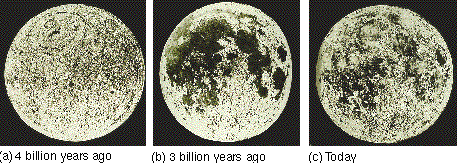Given all the data, can we construct a reasonably consistent history of the Moon? The answer seems to be yes. Many specifics are still debated, but a consensus exists. Refer to Figure 8.27 while studying the following details.

Figure 8.27 Paintings of the Moon (a) about 4 billion years ago, after much of the meteoritic bombardment had subsided and the surface had somewhat solidified; (b) about 3 billion years ago, after molten lava had made its way up through surface fissures to fill the low-lying impact basins and create the smooth maria; and (c) today, with much of the originally smooth maria now heavily pitted with craters formed at various times within the past 3 billion years.
The Moon apparently formed about 4.6 billion years ago. The approximate age of the oldest rocks discovered in the lunar highlands is 4.4 billion years, so we know that at least part of the crust must already have solidified by that time and survived to the present. At formation, the Moon was already depleted in heavy metals compared with Earth.
During the earliest phases of the Moon's existence—roughly the first half billion years or so—meteoritic bombardment must have been frequent enough to heat and remelt most of the surface layers of the Moon, perhaps to a depth of 400 km. The early solar system was surely populated with lots of interplanetary matter, much of it in the form of boulder-sized fragments that were capable of generating large amounts of energy on collision with planets and their moons. But the intense heat derived from such collisions could not have penetrated very far into the lunar interior. Rock simply does not conduct heat well.
This situation resembles the surface melting we suspect occurred on Earth from meteoritic impacts during the first billion years or so. But the Moon is much less massive than Earth, and it does not contain enough radioactive elements to heat it much further. Radioactivity probably heated the Moon a little, but not sufficiently to transform it from a warm, plastic object to a completely liquid one. The chemical differentiation now inferred in the Moon's interior must have occurred during this period. If the Moon has a small iron core, it also formed at this time.
About 3.9 billion years ago, around the time that Earth's crust solidified, the heaviest phase of the meteoritic bombardment ceased. The Moon was left with a solid crust, which would ultimately become the highlands, dented with numerous large basins, soon to flood with lava and become the maria. Between 3.9 and 3.2 billion years ago, lunar volcanism filled the maria with the basaltic material we see today. The age of the youngest maria—3.2 billion years—indicates the time when the volcanic activity subsided. The maria are the sites of the last extensive lava flows on the Moon, over 3 billion years ago. Their smoothness, compared with the older, more rugged highlands, disguises their great age.
Small objects cool more rapidly than large ones because their interior is closer to the surface, on average. Being so small, the Moon rapidly lost its internal heat to space. As a consequence, it cooled much faster than did Earth. As the Moon cooled, the volcanic activity ended as the thickness of the solid surface layer increased. With the exception of a few meters of surface erosion from eons of meteoritic bombardment, the lunar landscape has remained more or less structurally frozen for the past 3 billion years. The Moon is dead now, and it has been dead for a long time.
Like the Moon, Mercury seems to have been a geologically dead world for much of the past 4 billion years. On both the Moon and Mercury, the lack of ongoing geological activity is a consequence of a thick solid mantle that prevents volcanism or tectonic motion. Because of the Apollo program, the Moon's early history is much better understood than Mercury's, which remains somewhat speculative. What we do know about Mercury's history is learned mostly through comparison with the Moon.
When Mercury formed some 4.5 billion years ago, it was already depleted of lighter, rocky material. We will see later that this was largely a consequence of its location in the hot inner regions of the early solar system, although possibly a collision stripped away some of its light mantle. During the next half-billion years, it melted and differentiated, like the other terrestrial worlds. It suffered the same intense meteoritic bombardment as the Moon. Being more massive than the Moon, Mercury cooled more slowly, so its crust was thinner and volcanic activity more common at early times. More craters were erased, resulting in the intercrater plains found by Mariner 10.
As the planet's large iron core formed and then cooled, the planet began to shrink, compressing the crust. This compression produced the scarps seen on Mercury's surface and may have prematurely terminated volcanic activity by squeezing shut the cracks and fissures on the surface. Thus Mercury did not experience the extensive volcanic outflows that formed the lunar maria. Despite its larger mass and greater internal temperature, Mercury has probably been geologically inactive for even longer than the Moon.